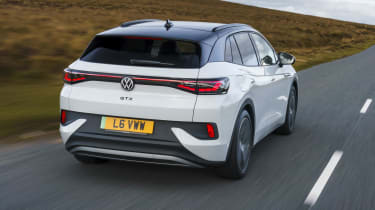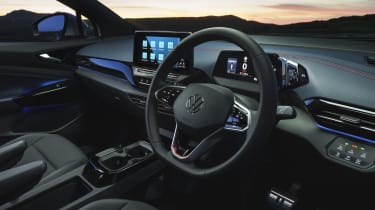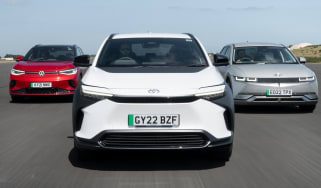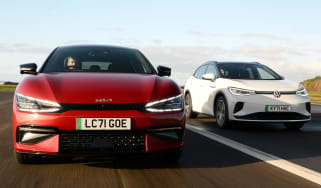Volkswagen ID.4 GTX review
VW’s first attempt at a performance electric car handles well for a 2.2-tonne SUV and offers decent performance, but isn't as thrilling as it should be
Pros
- Instant torque
- Good charging speeds
- As practical as any ID.4
Cons
- Quite expensive
- Confusing infotainment
- Not involving enough to drive
| Car type | Range | Wallbox charge time | Rapid charge time |
|---|---|---|---|
| Electric | 298 miles | 12hrs 15mins (0-100%, 7.4kW) | 34mins (10-80%, 125kW) |
The ID.4 GTX is Volkswagen's first electric performance car and it also marks the introduction of the company's new 'GTX' badge, which is set to appear on the most powerful versions of its zero-emissions models – making it an electric equivalent of 'GTI'.
All signs are that an ID.3 GTX hot hatchback is on the way, but the ID.4 GTX was first out of the gates, and straight away it faces competition from faster variants of electric SUVs like the Ford Mustang Mach-E, Kia EV6 and Tesla Model Y. So how does VW’s ‘high-performance’ electric SUV stack up?
On paper, the numbers look pretty good. There's a dual-motor setup (one on each axle) that produces a total of 295bhp, driving all four wheels. Paired with a 77kWh battery, this is effectively the same powertrain used in the top-of-the-range Audi Q4 50 e-tron quattro. And much like its Audi sibling, the ID.4 GTX will sprint from 0-62mph in 6.2 seconds and go on to a top speed of 111mph.
While it has two electric motors for all-wheel-drive capability, the ID.4 GTX is a rear-wheel-drive SUV most of the time; the front motor is only used when you need more traction or more performance. And despite weighing in at 2.2 tonnes – more than a long-wheelbase Mercedes S-Class – the car handles surprisingly well, even when you encounter tighter corners, thanks in part to the battery's weight sitting low in the body.
Those numbers make the ID.4 GTX is quite satisfying to drive in everyday situations, capable of delivering an instant hit of torque out of bends. The chassis has also received some upgrades, including stiffer springs, firmer dampers and tweaked anti-roll bars, so it turns in and changes direction better than the standard ID.4, and has more grip. Ride comfort is still decent, however.
But does it match the driving thrills provided by a petrol-engined VW bearing the GTI badge? The short answer is no. It's not even as agile as a Mustang Mach-E and its performance could be fairly described as adequate rather than spellbinding. The steering is a bit weightier than the standard ID.4's, but still doesn't have as much feel and feedback as we'd like. The lack of any engine noise also detracts from the driving experience – Volkswagen has elected not to follow Porsche's lead in installing an artificial sound synthesiser to make up for this.
And what about range? Does all that power and acceleration leave you needing a charge every few miles? Well, the official figure is 298 miles, while our test car showed a maximum of 224 on a full charge – and that turned out to be accurate over a mix of motorway, urban and rural roads during our time with it. Thankfully, the 125kW rapid charging capability that higher-spec versions of the regular ID.4 get is standard, which means you can add 186 miles of range in just 30 minutes from a fast enough charger. If you recharge at home, it should take seven and a half hours using a typical wallbox.
Inside, the GTX comes with stainless-steel pedals, sports seats with red stitching and a sports steering wheel, along with 30-colour ambient lighting and the same 5.3-inch digital driver’s display and 10-inch touchscreen with voice control you’ll find the regular ID.4 as well. Unfortunately, the same confusing menu layout and occasionally tricky-to-use touch-sensitive interface are present, too. On the exterior styling front, the GTX gets some sportier design cues than the regular car, including new front and rear bumpers, a new rear diffuser and 20-inch alloy wheels.
Keeping the somewhat underwhelming driving experience in mind, however, it's debatable whether these visual enhancements are worth the ID.4 GTX's near-£50,000 asking price. A rear-drive Mustang Mach-E is cheaper, more fun to drive and almost as fast as the German car, so while the VW is a decent first stab at a fast zero-emissions machine, we can't put the GTX badge in the same hallowed bracket as GTI just yet.








